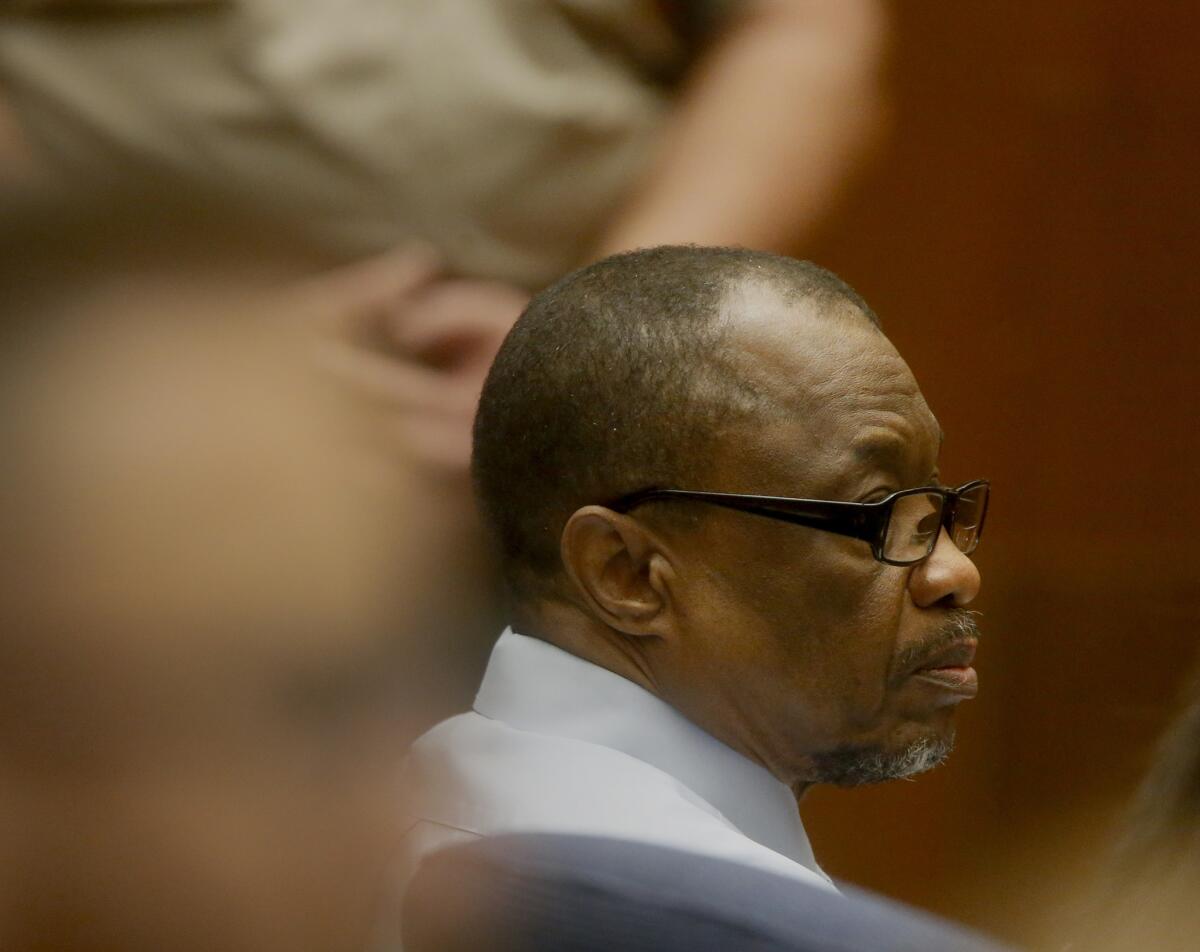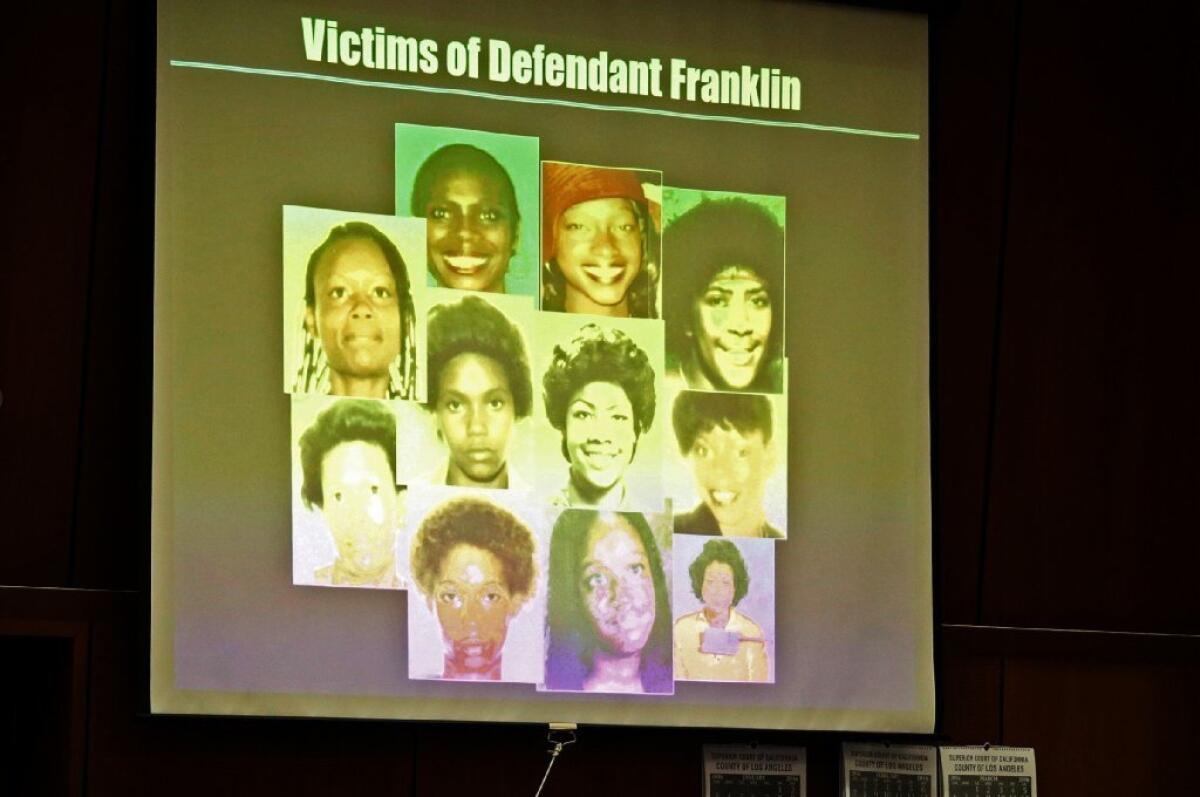After hearing a plea for mercy, jurors will decide if ‘Grim Sleeper’ should face death

- Share via
After listening to an appeal for mercy, jurors tasked with deciding the fate of the so-called Grim Sleeper began deliberating Friday whether one of Los Angeles’ most notorious convicted serial killers should be executed.
In his hourlong closing argument, Lonnie Franklin Jr.’s defense lawyer was by turns combative and emotional, attempting to both cast doubt on the prosecution’s case and telling jurors that a death verdict would “delay the healing process” for the victims’ families.
“Every time they think of the approaching execution date, it will be like opening the wounds again,” attorney Dale Atherton told the jury.
Franklin, 63, was convicted last month of killing nine women and one teenage girl during a decades-long series of attacks that terrorized South Los Angeles. Prosecutors linked an additional five killings to Franklin during the penalty phase of the trial but chose not to charge him with those slayings because doing so would have delayed the already long-stalled case.
See the most-read stories this hour >>
Jurors can return one of two verdicts for Franklin: life without parole or death. The jury had not reached a verdict as of 3:30 p.m., and Superior Court Judge Kathleen Kennedy allowed them to go home for the weekend, according to a spokesman for the Los Angeles County district attorney’s office.
Deliberations will resume at 9 a.m. Monday.
The same jury convicted Franklin largely on forensic evidence. Prosecutors argued that Franklin was connected to each of the 10 slain victims, as well as an 11th who survived, by DNA evidence, ballistics or both. Franklin’s DNA was found on seven victims.
A gun found in Franklin’s home was used to kill one woman, according to court testimony. Police criminalists testified that bullets from eight victims — seven of whom were killed and the one who survived — were fired from another weapon that was never recovered. Franklin’s DNA was on the bodies of three of those women, according to testimony.

But Atherton on Friday questioned the prosecution’s DNA evidence, telling jurors that the forensic evidence suggested other men besides Franklin had sexual contact with the victims before they died. He also repeatedly referred to prosecutors’ inability to produce what he termed “the mystery gun,” the weapon used in eight of the killings that was never recovered.
“Say you return a verdict of death, and five years, 10 years, 15 years from now, you hear the news that another suspect has been identified?” Atherton asked.
The defense attorney emotionally read aloud a 2011 news account about a woman who befriended her son’s killer in Minneapolis, decades after her son was fatally shot.
“The ripples of mercy will extend deeper and farther than the ripples of revenge,” he said.
The ripples of mercy will extend deeper and farther than the ripples of revenge.
— Dale Atherton, defense attorney
The defense attorney’s appeal for mercy stood in stark contrast to closing arguments delivered Thursday by Deputy Dist. Atty. Beth Silverman, who implored jurors to show Franklin “the exact same mercy” he showed to his victims.
“How do you give mercy to someone who is so clearly merciless?” the prosecutor asked at one point.
For 2½ hours, Silverman gave a blistering account of each crime, reminding jurors of the harrowing and humiliating way each woman was killed and left to rot in an alleyway or on a roadside. She repeatedly referred to life in prison as a lenient sentence, especially considering the long-term damage Franklin dealt to each victim and their loved ones.
“If you give him life in prison, it’s still life. It’s still more than his victims have. It means he still has a future, something to look forward to,” Silverman said. “The victims will never take another breath.”
Police believe Franklin, a former sanitation worker who lived in South L.A., may have killed as many as 25 women.
The killer was dubbed the Grim Sleeper because of an apparent 14-year gap in the killings — from 1988 to 2002 — though one of the slayings attributed to Franklin during the penalty phase of the trial occurred in 2000. Detectives believe the killer never “slept.”
Franklin’s victims were young and black, some leading troubled lives during the chaotic 1980s in South L.A. The bodies of many of the women — partly dressed or naked, some decomposing — were left along a corridor in the Manchester Square neighborhood,.
The deaths of the Grim Sleeper’s victims would not be connected for decades, and police kept the slayings quiet despite suspicions that a serial killer had been stalking young black women. That decision led to outrage and condemnation from many who attribute Franklin’s longevity as a killer to police indifference.
ALSO
A man posing as an officer is assaulting sex workers in Santa Ana, police say
Violent protests at Trump San Jose rally prompts criticism of demonstrators
L.A. council backs $198.5 million in financial aid for downtown hotel project
Follow @JamesQueallyLAT for crime and police news in Southern California.
UPDATES:
6:11 p.m.: This story was updated to reflect that the jury had not reached a verdict and will resume deliberations on Monday, along with other background about the case.
This story first published at 12:38 p.m.
More to Read
Sign up for Essential California
The most important California stories and recommendations in your inbox every morning.
You may occasionally receive promotional content from the Los Angeles Times.














